Top 11 Hotel KPIs to Track
Key Performance Indicators, or KPIs, provide a way to quantifiably measure a business’ progress. In other words, these indicators can help you see whether your business is reaching its performance goals. Naturally, KPI can vary from industry to industry, and from company to company. The hospitality industry is no different in this regard: there are a number of well-established hotel key performance indicators that can help you and your business. These KPIs can help you identify where your property has performed well, as well as areas where you should make some strategic adjustments.
Different KPIs provide insights into various aspects of a business's performance. By tracking multiple KPIs, businesses can gain a more holistic understanding of their overall performance rather than relying on a single metric, which may provide an incomplete picture. For example, a decrease in occupancy rate combined with an increase in average daily rate (ADR) may indicate changes in market demand or pricing strategies that need to be addressed.
Monitoring multiple KPIs can help businesses identify potential issues or risks early on before they escalate into larger problems. For example, a decline in customer satisfaction scores combined with a decrease in revenue per available room (RevPAR) may signal underlying operational issues that need to be addressed promptly.
Overall, tracking multiple types of KPIs simultaneously provides businesses with a more comprehensive and nuanced understanding of their performance, enabling them to make better-informed decisions and drive continuous improvement.
Here are some of the most important hotel KPI examples to pay attention to in hotel management:
1. Occupancy rate
In some cases, a hotel KPI can be rather self-explanatory. An occupancy rate, unsurprisingly, is a measure of percentage of your rooms are occupied compared to the total number of available rooms. This value is particularly useful when paired with other metrics such as ADR or RevPAR, which we will turn to shortly.
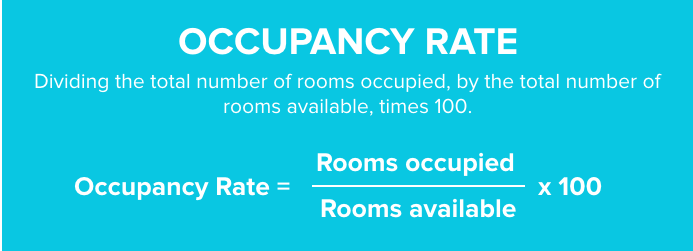
2. Average Daily Rate
Another useful KPI in the hotel industry is the Average Daily Rate, or ADR. This is a measure of the income gained from booked rooms over a specific period of time. Generally, this hotel KPI excludes complimentary or house-use rooms, since those don’t bring in revenue. The Average Daily Rate is calculated by dividing the revenue earned from booked rooms by the number of those rooms.
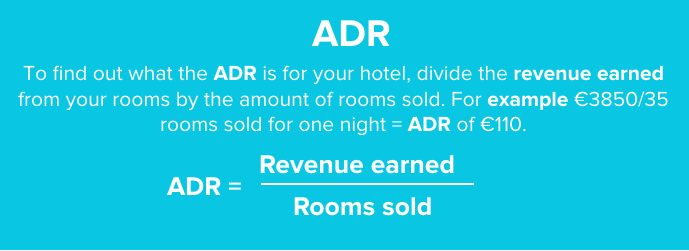
3. Revenue Per Available Rooms - RevPAR
Also known as Revenue Per Available Rooms, RevPAR is a measure of the hotel’s average daily rate and its ability to actually fill rooms. This hospitality KPI is a combination of revenue and occupancy performance. The goal of this metric is to help you make the most money out of each room in your hotel.
Just to briefly explain: if your occupancy rate is low, you may need to reduce room rates. On the other hand, if your rooms are constantly booked, you should increase your prices, in order to increase your hotel’s revenue. Remember—the goal is not just to have your rooms filled, it’s to have the greatest number of rooms filled at the highest price possible.
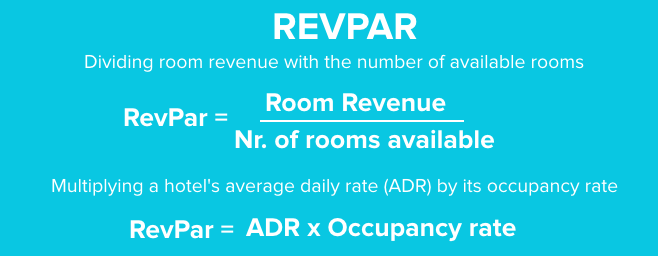
4. A Revenue Overview - TRevPAR
Another lengthy acronym, TRevPAR, is providing a measure of Total Revenue Per Available Rooms. This metric gives you a bigger picture of the entire hotel’s revenue performance. TRevPAR differs from RevPar in that it deals with more than just bookings. To calculate this measure, you need to take the total revenue of all divisions inside the hotel (including room service, wellness treatments, etc.), and then divide by the number of rooms.
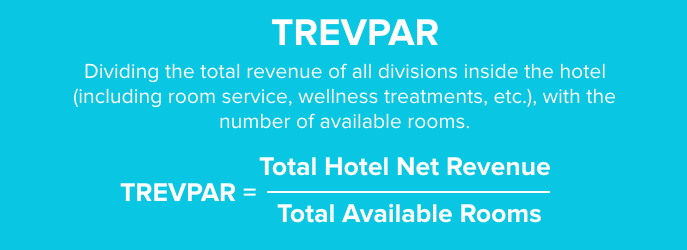
5. Revenue and Guest Spending Habits - TRevPeC
While it may seem like a bit of a tongue twister, TRevPeC, or Total Revenue Per Client, is actually rather easy to understand. As its name implies, this is meant to highlight your guests’ individual spending habits, and the relationship between these habits and your hotel’s revenue stream. To figure out your accommodation’s TRevPeC, simply divide your total revenue with the number of guests staying at your hotel.
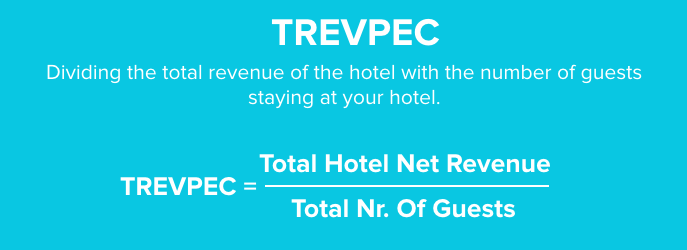
6. Understand Operating Profits - GOPPAR
Now we come to Gross Operating Profit Per Available Rooms, or GOPPAR. This metric, like others we’ve already mentioned, provides a birds’-eye view of how your business is doing. Dividing the overall gross operating profit of the hotel, and dividing it by total number of available rooms, gives you this particular figure.
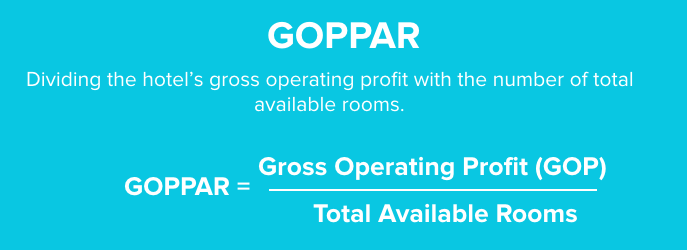
7. How Long are They Staying - LOS
As a hotel, it’s obviously useful to have a sense of how long your guests’ tend to stay. The LOS, a measure of the average length of stay does just that. This hotel KPI is derived through a division of the total number of occupied room nights by the number of bookings. Here, it’s important to keep in mind that longer stays are more profitable, and should be encouraged. After all, every time a guest leaves, you have to deal with labor costs of cleaning and preparing the room for its next inhabitant, meaning that minimizing turnover can definitely help increase revenue.
8. Rates in the Long Run - ARR
While the Average Daily Rate (ADR) lets you see room prices in the short time, sometimes longer-term trends can be helpful. The ARR, or Average Room Rate, is a hospitality industry KPI designed for precisely this: it gives you an average of rates over weeks or even months.
9. What’s a Room Costing You? CPOR
Thus far, we’ve mainly been discussing revenue. As you’re doubtless well-aware, it’s important to keep careful track of one’s expenditures as well. To that end, the CPOR, or Cost per Occupied Room, provides you a very useful breakdown of your operating costs. Keeping track of your CPOR, and working to keep it low, can help you and your hotel grow and become more profitable.
10 . Pickup
Pickup is a description of the pace of your hotel’s bookings. In other words, this hotel KPI measures how quickly rooms are “picked up” on the market. As we’ve already mentioned, many KPI in the hospitality industry are deeply interrelated. In this case, a pickup report should include the hotel’s occupancy rate, and its average daily rate, or ADR. An examination of your accommodation’s pickup can help you plan rate changes, discounts, and promotions, or dynamic pricing as you can use it to monitor results and adjust accordingly.
11. Earnings Before Interest, Taxes, Depreciation, and Amortization
EBIDTA shows the net earnings, including the earnings before interest, taxes, depreciation, and amortization. It can be used to compare the underlying hotel profitability against competitors. Earnings Before Interest, Taxes, Depreciation, and Amortization (EBIDTA) serves as a comprehensive measure of a hotel's profitability and cash flow generation potential. Hotels can utilize EBIDTA to assess their financial performance over time, compare against industry benchmarks, and demonstrate financial health to potential investors or buyers. Strategies to leverage EBIDTA effectively may include optimizing revenue streams, controlling operating expenses, investing in revenue-generating assets or initiatives, and implementing efficient cost management practices. Additionally, hotels can use EBIDTA as a tool for strategic decision-making, such as determining optimal pricing strategies, resource allocation, and investment prioritization to drive long-term profitability and sustainable growth.
While this list is far from exhaustive, it should serve to show that hotel KPIs are fare more than absurd acronyms and industry jargon (though they can be that). Rather, when employed carefully, they are crucial tools that can help you carefully monitor your hotel’s performance. Keeping these relatively simple indicators in mind can, when done correctly, make a world of difference.
For more hospitality insights, read our other blog post about hotel rate parity!




